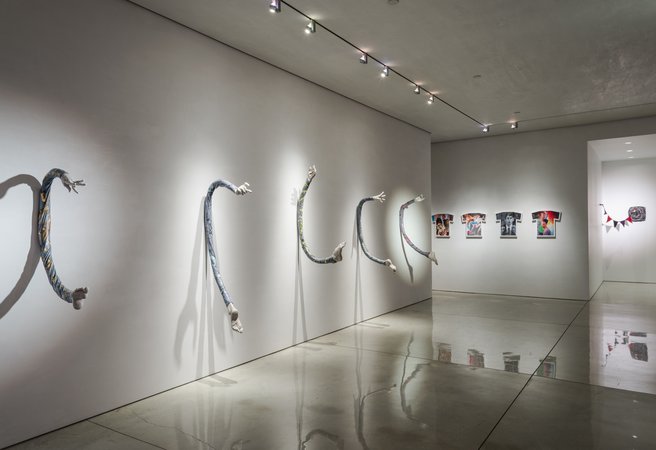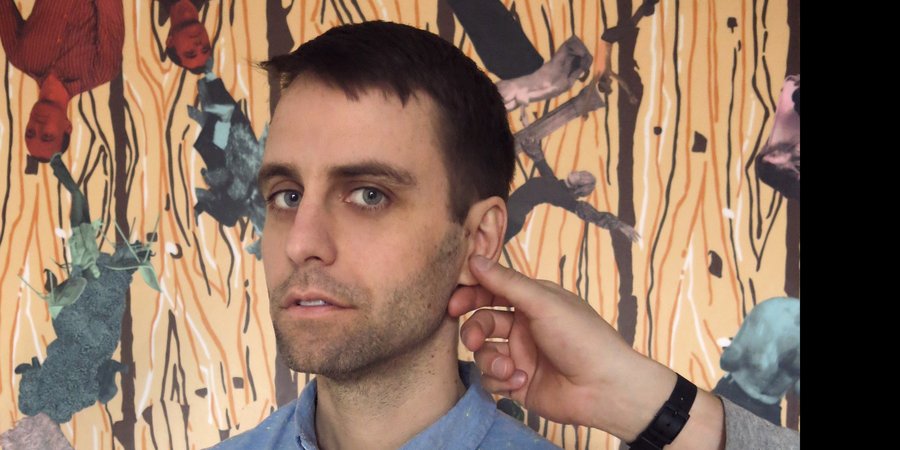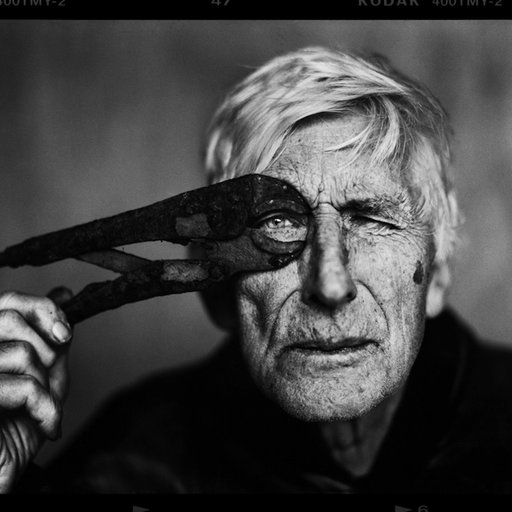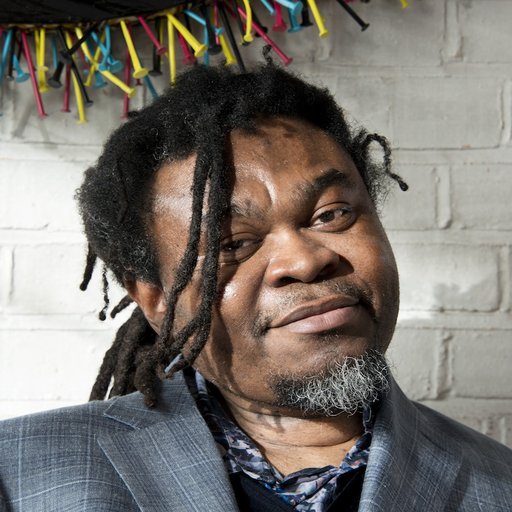Ryan McNamara is coming off a big year, with the past several months seeing the New York-based performance and video artist staging major productions around the world, from Hong Kong—where his piece Score during Art Basel HK fused tropes from dance and gaming—to the High Line commission Misty Malarky Ying Yang to Miami, where his ambitious performance MEƎM4 Miami: A Ballet About the Internet was the most-talked-about critical success of Art Basel Miami Beach. At once approachable and tangily conceptual, McNamara's work combines the medium of dance and the idiom of performance art to create immersive, witty pieces that reimagine the relationship between performer, audience, and the technologies that bind them.
On top of his efforts for the stage, McNamara was also preparing for an exhibition of studio works, organized by the curator Piper Marshall for Mary Boone Gallery. Crafted largely from costumes and props left over from his past performances, the sculpture abstract his dancers’ bodies down to their arms and legs, encased sausage-like in unitards, with disembodied hands reaching out to the viewer, all lit by a series of programmed lights that are liable to shift in the blink of an eye. These are highly personal objects, demonstrating the artist’s feel for materials as well as a subtle sense of showmanship. We caught up with McNamara to discuss his path to the Mary Boone show, the supposed ephemerality of performance art, and why he’s not quite ready to call himself a choreographer.
Last year was a big one for you, with a wide variety of your work being presented around the globe. What tied all of the pieces together?
After collaborating with the Dallas Symphony on a piece called Movement in April, I went to Hong Kong in May to premiere my piece Score. I brought six dancers from New York who worked with 14 Hong Kong-based dancers. The piece considered the ideas I was working with in MEƎM, about attention span and audience relationship. “Score” means 20—as in “four score and seven years ago—so it was 20 dancers doing 20 performances in 20 minutes. The result was this nonstop barrage of information coming at the audience from every direction. After that, I started working immediately on my High Line commission Misty Malarky Ying Yang, which premiered in July. The piece involved four dancers, all of whom had been in Hong Kong as well, so rehearsals for Score led right into Misty Malarky Ying Yang rehearsals, which ran right into MEƎM4 Miami rehearsals. So from March to December this core group saw a lot of each other, in many different hotel rooms and performance spaces and everywhere in between. And all the while I was planning this gallery show with Mary Boone.
How did the show come about?
Piper Marshall, who curated the show, actually asked me about a year ago if I would be interested in showing something at Mary Boone. It took a while to make it official because of my schedule, but it was probably about six months ago that we decided on a date. At first I thought, “this is insane, I’m going to come back from Miami and have less than a month to put it together.” But on the other hand I realized that after this crazy performance-focused period it was ultimately a good thing to push me to continue my studio practice, which is important for me to maintain for many reasons. Working with all of these people is obviously amazing and it’s a huge reason I do what I do, but at the same time it’s really nice to be able to go into my studio and work on something myself, to figure something out on my own. And it’s a lot easier to schedule [laughs].
It was nice to be able to have those two things to go in-between. MEƎM4 Miami was the biggest project I’ve ever done in terms of number of performers, so I thought that instead of just crashing right after it would be nice to have something lined up afterwards to keep that momentum going. It was slightly crazy on my part, really, December was just insane, but I’m actually really happy with the show. I hope that the vibrancy of the past six months continues within the gallery.
 A photo from MEƎM 4 Miami: A Ballet About the Internet
A photo from MEƎM 4 Miami: A Ballet About the Internet
Most people know you primarily for your performance and choreography work. How does your studio practice fit in?
I went to school and got my BFA in photography, so my interests started with the visual arts, mostly photography and sculpture. I grew up in Arizona, so I didn’t really know “performance” existed beyond traditional theater, and it definitely wasn’t being taught at Arizona State. I pieced together my own performance education, just doing performances and hearing things here and there. I met a few people in Arizona who had a performance background, but there was this amazing show in the late '90s in L.A. that I saw when I was a teenager called Out of Actions at MOCA, a huge survey show of performance objects put together by Paul Schimmel. It’s hilarious looking back, because at the time I didn’t know any of the people in it, but it basically encompassed the history of performance. That was a huge eye-opener for me—there was this whole world I didn’t know anything about. What I thought was interesting was that the show itself didn’t have performance in it. It was all objects. This was the start of my interest in the relationship between performance and the object. In a way, being in the studio is a little more comfortable for me, because I know that history much better. I work with dancers and I’m a huge dance enthusiast, but in terms of dance history I definitely know visual art’s history much better. For the past few years I’ve been doing performance after performance, and I love it, but its great to be able to get back into the studio and have people see that work as well.
How did you and Piper Marshall collaborate on the show?
Piper and I have known each other for seven years now, but this is the first project we’ve ever worked on together. I remember when we met, but I don’t know how exactly we became friends. We kept having these in-depth dialogues in places you usually don’t, at openings and benefits and things like that. This kind of thing kept happening and so, while I can’t speak for her, it just seemed to make sense for me to be a part of her series of shows at Mary Boone, because we were already in dialogue with each other. Since we hadn’t officially worked together before, she came to rehearsals for Score and Misty Malarky Ying Yang to get some insight into the way my brain and my practice works, even though it wasn’t necessarily directly related to our Mary Boone show. She would ask questions and encourage me to think about how my performative concerns could translate to the gallery.
What kind of considerations were at play in terms of how you positioned your work within the gallery space?
A lot of credit has to go to Mary. She’s done this a few times before, and she’s amazing. She would have the art handlers hold a piece on the wall and she’d say, “That’s at 62 inches?” And they’d measure it and it would be exactly sixty-two. You know? That’s an amazing thing. This was Piper’s first show with her, and I think both of us learned a lot from Mary. She's so open to ideas, but also so good at what she does. There was this one placement that I’d come up with during the install, and Mary was fine with it, but she brought up a few points about it with me anyway. I went home and thought, “Wow, we’re going to have to really battle this one out tomorrow,” but when I woke up in the morning I realized, “Shit, she's so right.” The number of shows she’s put up… I don’t know if she's even kept count, but it’s at least four hundred plus. It was amazing to have her as a resource, and a lot of the credit goes to her.
There is clearly a dialogue between the works at the gallery and your performances over the past year. How does that interplay manifest during the construction of these objects? Do you make the props and costumes for your performances in a similar fashion?
Yes, definitely. For example, my studio manager and I had to design the “people movers” in MEƎM [which ported audience members through through the dance, like in an amusement park ride] because they didn’t exist in the world. Of course some of the garments are purchased, but I put together all the costumes. In a way, I’m making stuff constantly for the performances and video work—these are all aesthetic and visual decisions, so the two make sense together. They’re essentially the same process. One thing of the biggest lies in contemporary art is this idea that performance is ephemeral. Yes, obviously there’s an aspect that is, but I also have a storage unit that will tell you differently [laughs].
 An installation view of the Mary Boone show
An installation view of the Mary Boone show
For me, these objects have a real history, a meaning, and there’s absolutely no way I can get rid of them. I had this idea that while the props and costumes were sitting inactive in bins, they desired to create their own performances, Fantasia-style, embodying what they thought the performance was. Sometimes they were successful and sometimes weren’t. They don’t pay attention to the distinction between my different performances, so there are props from one performance that are overlaid with images from another. One of the major conversations within performance is the question of how to deal with the secondary audience, with the people who weren’t there for the live piece. I think that attempting to replicate that experience is silly—it’s going to feel empty. Instead I looked at the images and props and costumes as raw materials, attempting to see them with fresh eyes, as if I’m excavating a site.
It’s almost as if you’re remixing this physical documentation of your performances.
That’s a really interesting way of putting it. In a way, that’s how I describe the choreography that I’ve been doing, because it’s all based on existing choreography that I’ve slowed down or sped up or chopped up in many different ways. You know, some magazine article just called me a choreographer, and it just feels weird.
You don’t identify as a choreographer?
I mean, I am, I guess. I’ve choreographed many, many pieces now, but, like I said, it’s not my background. I remix choreography, in a way, or that’s how I’ve been putting it, but I’ve never made the connection to remixing these objects. Huh. Interesting [laughs]. Thank you for that.
Glad I could help. On the subject of the secondary audience, and also getting into some more nitty-gritty questions of funding, you’re really working with two discrete business models here, the performance and the gallery. Would you be willing to talk about the different ways they operate?
I’m more than willing to answer those questions. It’s a funny thing about art—there’s such secrecy around money. I understand it’s a little gauche to talk about money, but at the same time, because there is this secrecy around it, it’s a challenge as a young artist to figure out how people make a living doing this. I have to pay my rent every month too. It is a funny mix of stuff, but so far so good. For a few years now, five I think, I’ve been able to do this without a day job, and I feel so insanely blessed. It’s such a crazy mix of income sources. You do commissions here, you sell a photograph there, and at a certain point hopefully that’s enough to ride you. I’ve had so many close calls through the years, but somehow things come through in the end.
I think that a lot of artists work this way, where their income comes from weird sources. I’m definitely not someone who just gets a check from a gallery once a year. It’s a very motley group of endeavors. And it’s definitely a source of... I don’t want to say panic, but nervousness, at all times. In the back of your head, you’re thinking, “Alright, this year is fine, but what about next year?” Especially when you’re doing bigger projects, you have to think about paying your studio assistants and your performers. The bigger the projects, the more nervous you get, because there’s more people to pay. It’s important to me to pay people a fair wage for what they’re doing. You gotta hustle to be able to do that.
One of the most remarked-upon aspects of MEƎM4 Miami is the way you managed to choreograph the movement of the audience itself. Obviously it’s difficult to exercise that amount of control in the gallery setting in terms of what someone is looking at and when. Was that a concern for you when setting up this show?
I have an ongoing interest in the relationship between the audience and the art object or performer. Sometimes it’s a subtle thing, and sometimes, as in the case of MEƎM, it becomes more central. At the same time, MEƎM starts with a very traditional audience-performer relationship which only later is shifted. It’s more about tweaking the preexisting conditions of these venues. I’d just come off of a year of working mostly in theatrical venues and so I thought about the different modes of viewership that a gallery and a theater have. In a gallery you are much more likely to have a solitary experience, or one with a small group, versus this collective experience with hundreds of people in the theater. After building all of these collective performative experiences thinking about the loneness of the gallery experience almost felt eerie to me.
I wanted to import an aspect of this theatrical world that would subtly rupture the traditional gallery viewing experience. For the most part, the show has constant, normal gallery lighting, but then every once in a while one of the lights shifts. The flood lighting might turn into a spotlight and drift down to the ground; the white light might fade into purple and then snap back. There’s one beam that goes wild for four seconds, changing color and traveling all over the room. I’ve lit the pieces as if they’re performers, but again, at first glance, it’s a traditional setup. If you’re in there alone, chances are you’ll first see something happening in the corner of your eye—you’ll just catch a little movement. It was a way for me to bring movement into the gallery in a hopefully unexpected way. Again, it’s subtle—it’s not someone coming up behind you with a people mover and carting you off—but it’s important for me to keep that relationship dynamic. Sometimes it’s a small tweak and sometimes it’s a big one.
 Another installation view of the Mary Boone show
Another installation view of the Mary Boone show
I’m an audience member as much if not more than I am presenter of work, so I ask myself, “What would surprise me in this scenario?” I also took into consideration the traffic flow of an uptown gallery, which is very different from Chelsea where you're running from gallery to gallery. It’s much more of a destination, so I wanted to reward these audience members with something that you can’t capture in installation shots or on Instagram. The lighting is enticing—the smaller room in the back of the gallery turns into a disco for five seconds. At the opening I loved seeing people pull out their phones to capture this moment, but by the time they get it out it’s over.
On the subject of social media, your last several performances have taken issues around technology and the Internet as central concerns, but I also noticed that you also included some very subtle reminders of the presence of technology in our lives in your gallery works, in the form of an iPhone, jump drive, chargers, etc. What are your thoughts on this interface between technology and performance, the gallery, and our “non-art"lives?
Phones have been a real presence in my performances. Not only are they props, but the audience instantly pulls out their phones as soon as a piece starts.
They actually take pictures on their phones during the performances?
Oh yeah.
What are your thoughts on that?
While it’s a no-no in the performance world, I never tell people in the beginning of a piece to turn off their phones. It’s up to them what they do with that, but I don’t discourage it. There's a desire in the audience to capture this, and that’s interesting to me. It also allows me to experience the work in ways that I wouldn’t have otherwise. I get to see angles of the piece that I’ve never seen. It’s just become so present.
For my last New York gallery show, Still at Elizabeth Dee, I created a performance-still factory which very much engaged the audience and photography. When an audience member came in the gallery, I would approach them and ask them to come up with a performance still with me that hopefully would look like it was a moment from a much larger performance. My collaborator Sam Roeck and I worked with them very quickly—most of them were in and out of there in four minutes—and we created five hundred performance stills in three weeks. The images were emailed to the participants, and it’s so funny—even two years ago, Instagram existed, I think, but it wasn’t what it is now. You just didn’t have people taking photos of the show and posting them in the way they would now. So the “official” photo that I sent became the only representative image, whereas now there would be so many versions of it. We were able to control people’s experience in a way we can’t now, and I find this shift exciting.
Actually, to jump back the current show, there’s a funny thing about that jump drive in Gently Used, a kind of Easter egg. There’s actually a video on it. No one seems to even see it in that piece, because it’s white on white. These are artists’ tools now, jump drives and whatnot. My studio is just props and costumes and jump drives and phones and cords, all tangled together in my everyday experience. These devices are so present in the creation of the work as well as its reception, and acknowledging that was important for me.
Speaking of subtleties in this show, one of my favorite works was the one with three French-manicured fingers poking out of a sleeve, such that if you looked closely enough you could see that that the ends were actually a little bloody, with the bones sticking out. I loved that very small moment of gore in what is otherwise a very “clean” show.
Yeah, I’m glad you noticed that. It’s really a collapse of this sterile technology, the bloodless screen, with the human body, which is at once the most desirable and disgusting thing in the world. I love how this pristine technology becomes grimy once humanity gets its hands on it. The human body infects the sleek, streamlined, contoured technoworld with its skin cells and filth. The body and technology are two interests of mine, so of course I’m really interested in all aspects of their collision. It’s not a gory show at all, but there are these little moments that display the body being very bodily in it.
Last question: what’s the point of all this? Why do this kind of work at all?
[Laughs] Sometimes I feel like if I didn’t have to I wouldn’t. It’s a weird drive. I mean, I tried once when I was about 27 to stop being an artist. I had a job I actually liked in social services that was totally rewarding, and I just thought, “Well, I moved to New York to be an artist, but maybe this is what I’m going to do.” I don’t know. It’s hard—being an artist is hard. It kind of hurts, in a way, and so I was thought, “Why do I do this to myself?” That lasted for about six months, until I started projects but not calling them projects. In a way I don’t even have the luxury to say why I’m doing this, because I have to. I don’t know why [laughs]. I think that it’s a process of figuring out “why?” as I go along. If I did know maybe I could stop. For now I’m still figuring it out.
























